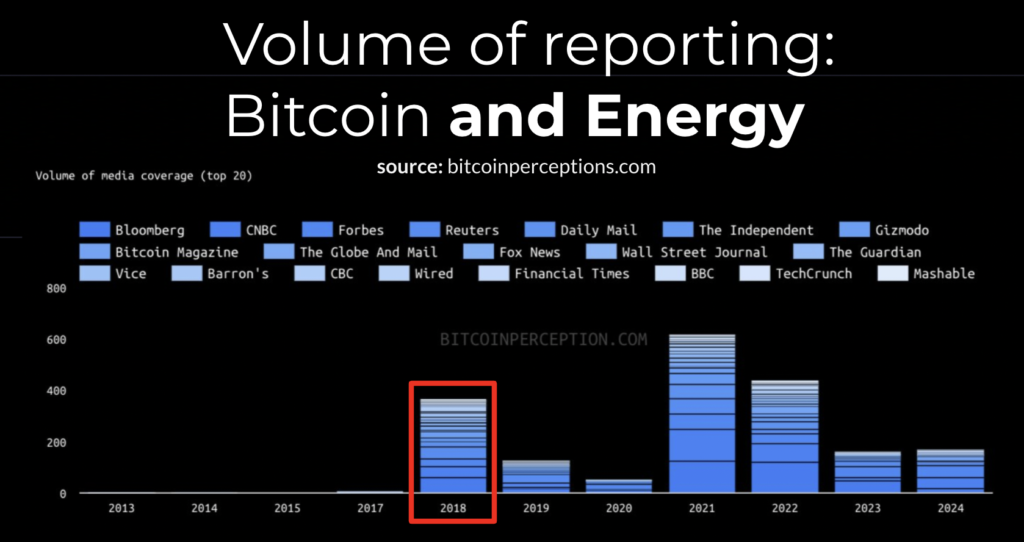On May 2018 Alex de Vries wrote a 5 page commentary called Bitcoin’s Growing Energy Problem
The word commentary is important. According to Nature commentaries are shorter, have a lighter review process and “often reflect the author’s perspective, rather than reporting new data.”
De Vries’s article was a commentary… and his perspective was “We can measure Bitcoin’s use of energy per transaction to show that the Bitcoin network cannot scale without vastly increasing emissions.
His commentary was a media hit. In 2017 there was 1 article on Bitcoin’s energy usage. In 2018, the year of de Vries’ article, there were over 400.

The problem is that his perspective was invalid, because Bitcoin’s energy use does not come from its transactions, meaning it could handle 1000x more transactions, yet use no more energy.
Cambridge University immediately dismissed the per transaction measure as “not a meaningful metric in the context of PoW blockchains”. But not only did the media and other authors keep citing the metric, but regulators, Central Banks, and NGOs joined in.

The per transaction metric was subsequently quadruply refuted in academic journals; by Masanet et al, 2019, Dittmar et al. 2019, Sedlmeir et al, 2020, and Sai and Vranken in 2023.
Yet the faux-metric continued not only to circulate, but to mutate:
- Energy per transaction mutated into
- Emissions per transaction, which became
- eWaste per transaction, which finally morphed into
- Water use per transaction

All four were the work of variants created through new De Vries studies.
De Vries under his own name or that of his blog Digiconomist went on to become the most frequently cited researcher in the media. His commentary was the origin point for every academic article on Bitcoin’s environmental impact over the next 5 years (which have now amassed collectively >4500 citations). In the Whitehouse’s 2022 report on cryptomining, de Vries/digiconomist was referenced 4x more than the next highest author. He was also the most cited author in GreenpeaceUSA’s ChangeTheCode campaign against Bitcoin.
There are two fundamental issues with metric upon which this narrative was built
- No causal link
The first is as we have said that there is actually no causal connection between transactions and Bitcoin’s energy consumption.
The reason that 5 subsequent studies rejected the per transaction metric, can be explained using an example we are all familiar with: a car audio system.
The average car emits 4600 kgs CO2 per year. And according to Statista, US drivers spend 6.4 hours per week listening to music in cars. With the average pop song being 4 minutes long, that’s 4992 songs per year.
We could claim that every song creates 0.92 kg CO2 emissions.<emissions per song>
Such a claim would be laughed out of any academic journal because playing songs doesn’t cause a car to consume petrol. The only reason that the equally incorrect per transaction metric for Bitcoin was not, was that in 2018, many academic editors still lacked understanding of how Bitcoin’s blockchain worked.
2.Semantic ambiguity
The second issue the authors who rebutted the per transaction metric cite is “semantic ambiguity”. Again, here’s an everyday example of how semantic ambiguity can mislead..
Imagine I agree to pay you one million dollars for a job. On completion of the job, you request payment and I send you one million Zimbabwean dollars. You would probably feel aggrieved.
Just as the word “dollar” has a very different meaning based on location, so does the word “transaction”. In the traditional finance world, a transaction means a ledger entry. In the Bitcoin world, a single blockchain transaction can contain over 2000 traditional transactions, and using the layer-2 network (Lightning network) billions of traditional financial transactions.
This false signal has helped persuade a large number of impact investors, regulators and environmentalists away from adopting Bitcoin.
